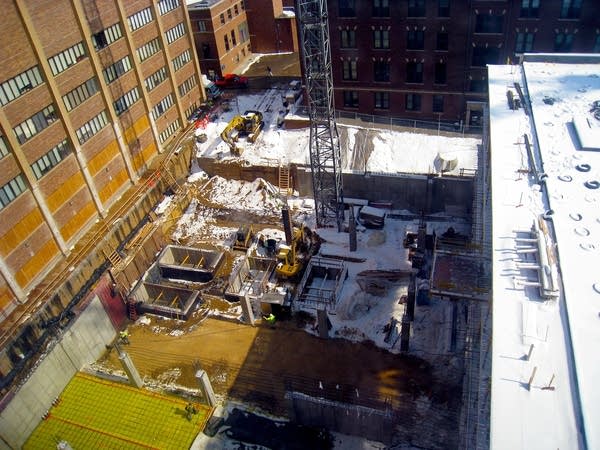Mayo's Saint Marys Hospital a priority for expansion
Go Deeper.
Create an account or log in to save stories.
Like this?
Thanks for liking this story! We have added it to a list of your favorite stories.

Saint Marys Hospital is usually a busy a place, so much so that it is chronically short of administrative and research space.
Doctors hustle across the Mayo Clinic hospital, which extends more than a city block, and emergency room nurses push carts from one patient room to another. Shared offices are the norm.
"I've got three people that work out of my locker in the operating rooms here because we don't have enough space," said Dr. Brad Narr, chair of the anesthesiology department. "That would have been unheard of in 1980 when these things opened up. They had plenty of extra lockers. And so as we add people to the staff it just creates needs for infrastructure and everything else we're doing."
To solve its space woes, the Mayo Clinic plans to spend $3 billion to expand in Rochester in the next 20 years. It's asking the state of Minnesota to pitch in $500 million to pay for public parking, transportation, transit, utilities and other improvements.
Turn Up Your Support
MPR News helps you turn down the noise and build shared understanding. Turn up your support for this public resource and keep trusted journalism accessible to all.
Lawmakers haven't decided whether the state should support the plan, but in Rochester how the hospital and clinic system might continue to expand its footprint is on the minds of many.
The Clinic already is adding four stories to Saint Marys Hospital and expanding the emergency room. Several blocks away, it's building a proton cancer therapy center and adding four floors to its healthy living center.
The project will include upgrades to 70 private patients rooms, a new ambulance garage, and new patient waiting areas.

But adding new space is not the only upgrade on the horizon, said Narr, a spokesman for the proposed expansion plan. Inside the hospital's surgical wing, there are few renovated rooms and only 8 of 70 pre- and post-operative beds have been upgraded.
"At Saint Marys, we're way behind in terms of modern pre- and post- operative care," he said. "It's secure. It's quiet. We have room for one patient in here. We have all their physiologic monitoring in here. We've standardized all of our infusion pumps throughout the entire place. So we're evolving to this for 100 percent of our patients."
To support its growth plans, the Mayo Clinic has accumulated nearly 500 acres of land in Rochester. WEB: 479.43 acres, as of Mayo's 2011 Five-Year Plan Update.
That includes warehouses, facilities and support centers on the outskirts of the city, as well as familiar downtown buildings and lots of parking lots.
Narr won't say definitively what Mayo's 20-year plan includes but he suggests the clinic may one day build research or administrative buildings on those parking lots or add up to 10 more floors to its flagship Gonda building.
Space is so tight in the downtown area, Mayo officials are also planning to have employees share unassigned work space, using a concept called "hoteling." The clinic rents 800,000 square feet of office space from non-Mayo buildings.
"I've got three people that work out of my locker in the operating rooms here because we don't have enough space... That would have been unheard of in 1980 when these things opened up."
That's pushed the downtown occupancy rate for commercial real estate to 97 percent of capacity, said Mike Wilson, regional property manager for Rochester-based Paramark Real Estate Services.
"When Mayo expanded off of its own campuses into these other buildings, they filled a void that the marketplace could never have filled," Wilson said.
If part of Mayo's long-term plan includes building new facilities and pulling out of its rented spaces, Wilson doubts the commercial real estate market would suffer.
"The ancillary businesses which will grow with Mayo and support Mayo would in-fill those considerably," he said. "I don't think we would go backward. I think there'd be more need for more non-Mayo space built."
Mayo Clinic officials also want to create a medical corridor connecting its two biggest facilities: Saint Marys Hospital and the Gonda building. The two are about five blocks away along 2nd Street.
Rochester recently reconstructed portions of the street, which carries an estimated daily traffic of 15,000 vehicles. It is often packed with city buses, the hospital system's own commuter buses and workers leaving downtown. The city added sidewalks, five new bus shelters and pedestrian crosswalks.
"We'd like the medical campus to be contiguous," Narr said. "So it's a little bit of an anomaly that Saint Marys is down here and Mayo is down there and it costs us a lot of money. We've got buses going back and forth. I can't have surgeons seeing patients and then coming back down here to operate."
Nearby business owner Joe Powers welcomes the spin-off business he's had from the Mayo Clinic's growing footprint, but the increase in traffic has been a concern.
"Pedestrians are getting hurt and the amount of traffic that is occurring -- people are darting between different facilities along a very busy road," he said.
Powers opened his Canadian Honker restaurant across the street from Saint Marys 29 years ago. He said a more cohesive corridor between the hospital and the clinic would be a boon for small businesses.
"I'm really hopeful for that because most people don't even consider us, even though we're only five blocks away from core of downtown," he said. "Yet we're in one of the ... busiest areas."
If the Mayo Clinic doesn't receive the state's help to expand in Rochester, clinic officials have suggested they might invest the $3 billion in its Florida or Arizona campuses.





